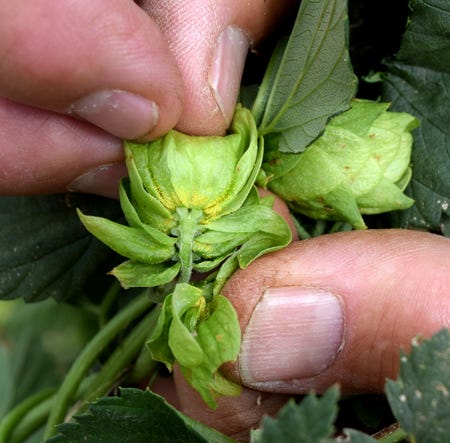November 17, 2020

Craft brewing is one of the fastest-growing niche markets in New Mexico.
Prior to the COVID-19 pandemic restrictions on businesses, including taprooms, there were 90-plus microbreweries in New Mexico, 40 of which were in the Albuquerque metroplex, according to the New Mexico Brewers Guild.
The Village of Los Ranchos is establishing itself in a supporting role of the industry as it strives to be the center of sustainable urban agriculture in central New Mexico.

New Mexico State University is also playing a role in the industry’s development through the College of Agricultural, Consumer and Environmental Sciences’ goal of increasing value-added product production in the state, and the College of Engineering’s NMSBrew engineering lab.
“The microbrewery industry is an ideal place for our Aligning Our Agri-Future program to be involved,” said Fergus Whitney, Los Ranchos’ agricultural programs manager. “We want to connect agricultural producers with breweries in the village and metroplex to benefit both groups.”
Microbreweries would like to have local sources for the ingredients of their beer. Hops, the bittering and flavoring agent in beer, can be grown in New Mexico.
“Our clientele wants local beer, and if it is made with local hops, that’s even better,” said Ken Wimmer, house brewer at Hops Brewery located in Los Ranchos. “We can get most of the hops we are looking for, but it is nice having locally grown hops.”
Los Ranchos’ first hops harvest this year was used by Hops Brewery to create Fergus’ Village Smash limited quantity of beer.
“I came up with recipes to highlight the hops that Fergus is growing,” Wimmer said. “Our clientele really liked the flavor. I hope to continue to work with Fergus with his hops project.”
Hope Variety Trials
Kevin Lombard, NMSU associate professor and superintendent at the Agricultural Science Center at Farmington, has conducted hops variety trials since 2008, when the microbreweries in the Four Corners region shared their concerns regarding having a source for hops.
Lombard has provided workshops on growing hops with the information he has gained during the variety trials.
“I’ve done several hops workshops in Los Ranchos to inform agricultural producers about the specialty crop,” said Lombard, who has written a research report title “Significance and Implications for Establishing Hop Production in New Mexico and Southwest Colorado,” available at https://bit.ly/38Nhsmz.
New Crop
Hops is a relatively new crop in Los Ranchos. Tom Brewer, owner of Red Hat Hops Farm, began growing it three years ago in the village. He is among nine growers located between Belen and Chama.
Red Hat Hops Farm is growing several varieties to see how they do in the New Mexican climate.
During the spring of 2019, Brewer helped Whitney establish a hops yard at Los Ranchos’ Larry P. Abraham Agri-Nature Center. Whitney is growing three additional varieties in the demonstration field.
Lombard plans to replicate the variety types being grown at the agri-nature center at the Farmington experimental farms in the spring of 2021.
“From these various trial crops, we should have a good idea of what grows best in the Rio Grande corridor,” said Lombard.
Labor-intensive Crop
One aspect of the hops crop is the labor-intensive harvesting of the bud cones if a mechanical harvester is not available.
“With the vines, known as bines, growing up to 20 feet high on guide strings, hand-harvesting the hops cones is time-consuming,” Lombard said. “After several years, we were able to purchase a harvester. Now we cut the bines down and run them through the machine.”
The harvester was purchased through a U.S. Department of Agriculture specialty crop block award through New Mexico Department of Agriculture.
Until hops growers can purchase a harvester, Lombard is developing a plan to loan NMSU’s harvester to growers.
“Kevin brought the harvester to the agri-nature center in Los Ranchos for our harvest,” Whitney said. “Tom was able to bring over their bines as well.”
 (Hops cones contain lupulus, the bittering agent used in beer. The Village of Los Ranchos Aligning Our Agri-Future program is helping to connect hops farmers with local microbreweries. New Mexico State University is providing research-based technical assistance to the farmers. NMSU photo by Jane Moorman.)
(Hops cones contain lupulus, the bittering agent used in beer. The Village of Los Ranchos Aligning Our Agri-Future program is helping to connect hops farmers with local microbreweries. New Mexico State University is providing research-based technical assistance to the farmers. NMSU photo by Jane Moorman.)
Hops can be used by brewers at various stages in the beer-making process to extract the bittering, flavor and aroma qualities from the cones.
Some beer recipes call for multiple varieties of hops to be added at different brewing stages depending on the hop cone chemical profiles and desired beverage outcome.
When developing a beer recipe, the brewer needs to know the hops’ alpha acid level, which provides the bitterness of the beer.
The College of Engineering’s brew engineering lab, NMSBrew, is able to conduct tests to provide that information. It is the only non-privately owned testing facility in New Mexico.
“We started in 2019 to provide this measurement for hops growers in the state,” said Catherine Brewer, associate professor in the chemicals and materials engineering department. “At the time there were eight hops growers in the state, so we had no more than two dozen samples. Ideally, we want our system to be able to provide testing to a wider range of hops growers.”
The testing also determines the beta acids in the hops that determines the hops’ storage index, or freshness index.
“This information helps brewers to predict how quickly they will need to use the hops before the blossoms reach the end of their shelf life,” Catherine Brewer said.
Source: is NMSU, which is solely responsible for the information provided and is wholly owned by the source. Informa Business Media and all its subsidiaries are not responsible for any of the content contained in this information asset.
Read more about:
HopsAbout the Author(s)
You May Also Like




